7. Repressor binds cooperatively at each operator using a helix-turn-helix motif
11.7 Repressor binds cooperatively at each operator using a helix-turn-helix motif |
Several DNA-binding proteins that regulate bacterial transcription share a similar mode of holding DNA, in which the active domain contains two short regions of α-helix that contact DNA. (Some transcription factors in eukaryotic cells use a similar motif, as discussed in 21 Regulation of transcription.)
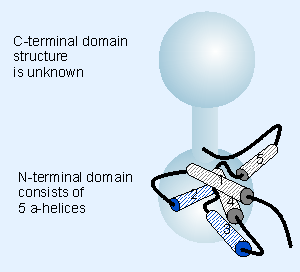 |
Figure 11.17 Lambda repressor's N-terminal domain contains five stretches of a-helix; helices 2 and 3 are involved in binding DNA. |
The N-terminal domain of lambda repressor contains several stretches of α-helix, arranged as illustrated diagrammatically in Figure 11.17. The structures of the connector and the C-terminal domain are not known.
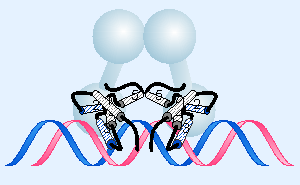 |
Figure 11.18 In the two-helix model for DNA binding, helix-3 of each monomer lies in the wide groove on the same face of DNA, and helix-2 lies across the groove. |
Two of the helical regions are responsible for binding DNA. The helix-turn-helix model for contact is illustrated in Figure 11.18. Looking at a single monomer, α-helix-3 consists of 9 amino acids, lying at an angle to the preceding region of 7 amino acids that forms α-helix-2. In the dimer, the two apposed helix-3 regions lie 34 Å apart, enabling them to fit into successive major grooves of DNA. The helix-2 regions lie at an angle that would place them across the groove (Sauer et al., 1982).
Related forms of the α-helical motifs employed in these two regions are found in several DNA-binding proteins, including CAP, the lac repressor, and several phage repressors. Each helix plays a distinct role in binding the operators:
- Contacts between helix-3 and DNA rely on hydrogen bonds between the amino acid side chains and the exposed positions of the base pairs. This helix is responsible for recognizing the specific target DNA sequence, and is therefore also known as the recognition helix.
- Contacts from helix-2 to the DNA take the form of hydrogen bonds connecting with the phosphate backbone. These interactions are necessary for binding, but do not control the specificity of target recognition. In addition to these contacts, a large part of the overall energy of interaction with DNA is provided by ionic interactions with the phosphate backbone.
What happens if we manipulate the coding sequence to construct a new protein by substituting the recognition helix in one repressor with the corresponding sequence from a closely related repressor? The specificity of the hybrid protein is that of its new recognition helix. The amino acid sequence of this short region determines the sequence specificities of the individual proteins, and is able to act in conjunction with the rest of the polypeptide chain (Wharton et al., 1984).
 |
Figure 11.19 Two proteins that use the two-helix arrangement to contact DNA recognize lambda operators with affinities determined by the amino acid sequence of helix-3. |
Figure 11.19 shows the details of the binding to DNA of two proteins that bind similar DNA sequences. Both lambda repressor and Cro protein have a similar organization of the helix-turn-helix motif, although their individual specificities for DNA are not identical:
- Each protein uses similar interactions between hydrophobic amino acids to maintain the relationship between helix-2 and helix-3: repressor has an Ala-Val connection, while Cro has an Ala-Ile association.
- Amino acids in helix-3 of the repressor make contacts with specific bases in the operator. Three amino acids in repressor recognize three bases in DNA; the amino acids at these positions and also at additional positions in Cro recognize five (or possibly six) bases in DNA.
Two of the amino acids involved in specific recognition are identical in repressor and Cro (Gln and Ser at the N-terminal end of the helix), while the other contacts are different (Ala in repressor versus Lys and the additional Asn in Cro). Also, a Thr in helix-2 of Cro directly contacts DNA.
The interactions shown in the figure represent binding to the DNA sequence that each protein recognizes most tightly. The sequences shown at the bottom of the figure with the contact points in color differ at 3 of the 9 base pairs. The use of overlapping, but not identical contacts between amino acids and bases shows how related recognition helices confer recognition of related DNA sequences. This enables repressor and Cro to recognize the same set of operators, but with different relative affinities for particular members of the group.
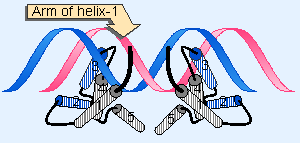 |
Figure 11.20 A view from the back shows that the bulk of the repressor contacts one face of DNA, but its N-terminal arms reach around to the other face. |
The bases contacted by helix-3 of repressor or Cro lie on one face of DNA, as can be seen from the positions indicated on the helical diagram in Figure 11.19. However, repressor makes an additional contact with the other face of DNA. Removing the last six N-terminal amino acids (which protrude from helix-1) eliminates some of the contacts. This observation provides the basis for the idea that the bulk of the N-terminal domain contacts one face of DNA, while the last six N-terminal amino acids form an "arm" extending around the back. Figure 11.20 shows the view from the back. Lysine residues in the arm make contacts with G residues in the major groove, and also with the phosphate backbone. The interaction between the arm and DNA contributes heavily to DNA binding; the affinity of the armless repressor for DNA is reduced by ~1000-fold (Brennan et al., 1990).
 |
Figure 11.21 Each operator contains three repressor-binding sites, and overlaps with the promoter at which RNA polymerase binds. The orientation of OL has been reversed from usual to facilitate comparison with OR. |
Each operator contains three repressor-binding sites. As can be seen from Figure 11.21, each binding site is a sequence of 17 bp displaying partial symmetry about an axis through the central base pair. No two of the six individual repressor-binding sites are identical, but they all conform with a consensus sequence. The binding sites within each operator are separated by spacers of 3 V7 bp that are rich in A PT base pairs. The sites at each operator are numbered so that OR consists of the series of binding sites OR1-OR2-OR3, while OL consists of the series OL1-OL2-OL3. In each case, site 1 lies closest to the startpoint for transcription in the promoter, and sites 2 and 3 lie farther upstream.
A repressor dimer binds symmetrically at each site, so that each N-terminal domain of the dimer contacts a similar set of bases. So each individual N-terminal region contacts a half-binding site.
Bases that are not contacted directly by repressor protein may have an important effect on binding. The related phage 434 repressor binds DNA via a helix-turn-helix motif, and the crystal structure shows that helix-3 is positioned at each half-site so that it contacts the 5 outermost base pairs but not the inner 2. However, operators with A PT base pairs at the inner positions bind 434 repressor more strongly than operators with G PC base pairs. The reason is that 434 repressor binding slightly twists DNA at the center of the operator, widening the angle between the two half-sites of DNA by ~3 X. This is probably needed to allow each monomer of the repressor dimer to make optimal contacts with DNA. A PT base pairs allow this twist more readily than G PC pairs, thus affecting the affinity of the operator for repressor.
Faced with the triplication of binding sites at each operator, how does repressor decide where to start binding? At each operator, site 1 has a greater affinity (roughly tenfold) than the other sites for the repressor. So the repressor always binds first to OL1 and OR1.
Lambda repressor binds to subsequent sites within each operator in a cooperative manner. The presence of a dimer at site 1 greatly increases the affinity with which a second dimer can bind to site 2. When both sites 1 and 2 are occupied, this interaction does not extend farther, to site 3. At the concentrations of repressor usually found in a lysogen, both sites 1 and 2 are filled at each operator, but site 3 is not occupied (Johnson et al., 1979).
If site 1 is inactive (because of mutation), then repressor binds cooperatively to sites 2 and 3. That is, binding at site 2 assists another dimer to bind at site 3. This interaction occurs directly between repressor dimers and not via conformational change in DNA. Probably the connector region of the first repressor orients the C-terminal regions of the dimer in such a way that they contact the C-terminal regions of the second dimer.
A result of cooperative binding is to increase the effective affinity of repressor for the operator at physiological concentrations. This enables a lower concentration of repressor to achieve occupancy of the operator. This is an important consideration in a system in which release of repression has irreversible consequences. In an operon coding for metabolic enzymes, after all, failure of repression will merely allow unnecessary synthesis of enzymes. But failure to repress lambda prophage will lead to induction of phage and lysis of the cell.
From the sequences shown in Figure 11.21, we see that OL1 and OR1 lie more or less in the center of the RNA polymerase binding sites of PL and PR, respectively. Occupancy of OL1-OL2 and OR1-OR2 thus physically blocks access of RNA polymerase to the corresponding promoters.
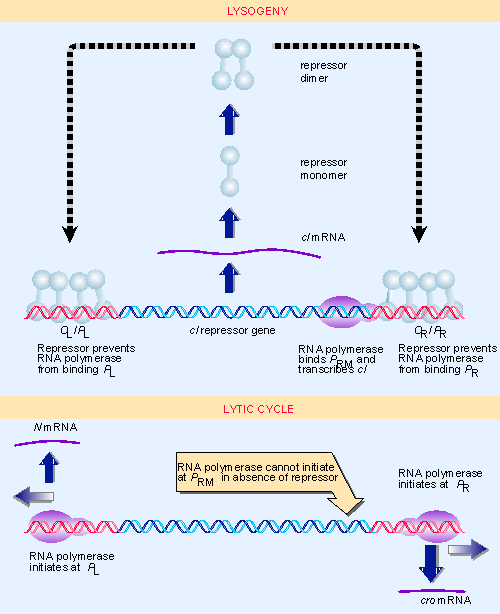 |
Figure 11.14 Lysogeny is maintained by an autogenous circuit (upper). If this circuit is interrupted, the lytic cycle starts (lower). |
A different relationship is shown between OR and the promoter PRM for transcription of cI. The RNA polymerase binding site is adjacent to OR2. This explains how repressor autogenously regulates its own synthesis. When two dimers are bound at OR1-OR2, the dimer at OR2 interacts with RNA polymerase (see Figure 11.14). This effect resides in the amino terminal domain of repressor.
Mutations that abolish positive control map in the cI gene. One interesting class of mutants remain able to bind the operator to repress transcription, but cannot stimulate RNA polymerase to transcribe from PRM. They map within a small group of amino acids, located on the outside of helix-2 or in the turn between helix-2 and helix-3. The mutations reduce the negative charge of the region; conversely, mutations that increase the negative charge enhance the activation of RNA polymerase. This suggests that the group of amino acids constitutes an "acidic patch" that functions by an electrostatic interaction with a basic region on RNA polymerase.
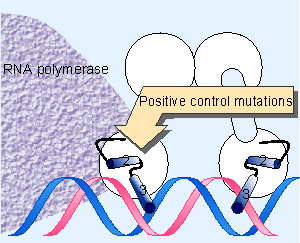 |
Figure 11.22 Positive control mutations identify a small region at helix-2 that interacts directly with RNA polymerase. |
 |
Figure 11.25 Positive regulation can influence RNA polymerase at either stage of initiating transcription. |
The location of these "positive control mutations" in the repressor is indicated on Figure 11.22. They lie at a site on repressor that is close to a phosphate group on DNA that is also close to RNA polymerase. So the group of amino acids on repressor that is involved in positive control is in a position to contact the polymerase. The interaction between repressor and polymerase is needed for the polymerase to make the transition from a closed complex to an open complex (see Figure 11.25 later). The important principle is that protein-protein interactions can release energy that is used to help to initiate transcription.
What happens if a repressor dimer binds to OR3? This site overlaps with the RNA polymerase binding site at PRM. So if the repressor concentration becomes great enough to cause occupancy of OR3, the transcription of cI is prevented. This leads in due course to a reduction in repressor concentration; OR3 then becomes empty, and the autogenous loop can start up again because OR2 remains occupied.
This mechanism could prevent the concentration of repressor from becoming too great, although it would require repressor concentration in lysogens to reach unusually high levels. In the formal sense, the repressor is an autogenous regulator of its own expression that functions positively at low concentrations and negatively at high concentrations.
Virulent mutations occur in sites 1 and 2 of both OL and OR. The mutations vary in their degree of virulence, according to the extent to which they reduce the affinity of the binding site for repressor, and also depending on the relationship of the afflicted site to the promoter. Consistent with the conclusion that OR3 and OL3 usually are not occupied, virulent mutations are not found in these sites.
| Research | |
| Brennan, R. G. et al. (1990). Protein-DNA conformational changes in the crystal structure of a lCro-operator complex. Proc. Nat. Acad. Sci. USA 87, 8165-8169. | |
| Johnson, A. D., Meyer, B. J., and Ptashne, M. (1979). Interactions between DNA-bound repressors govern regulation by the phage lrepressor. Proc. Nat. Acad. Sci. USA 76, 5061-5065. | |
| Sauer, R. T. et al. (1982). Homology among DNA-binding proteins suggests use of a conserved super-secondary structure. Nature 298, 447-451. | |
| Wharton, R. L., Brown, E. L., and Ptashne, M. (1984). Substituting an a-helix switches the sequence specific DNA interactions of a repressor. Cell 38, 361-369. | |